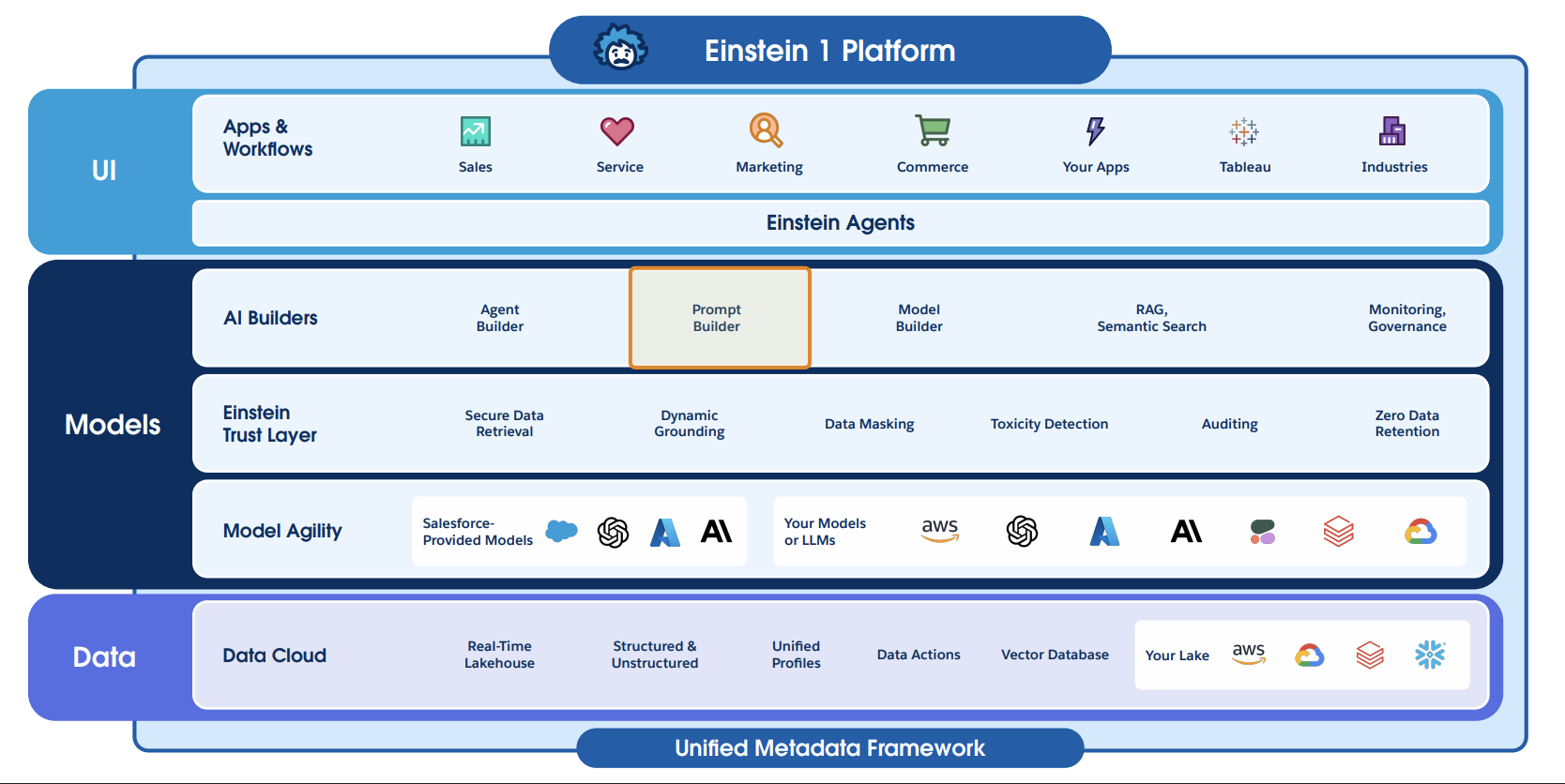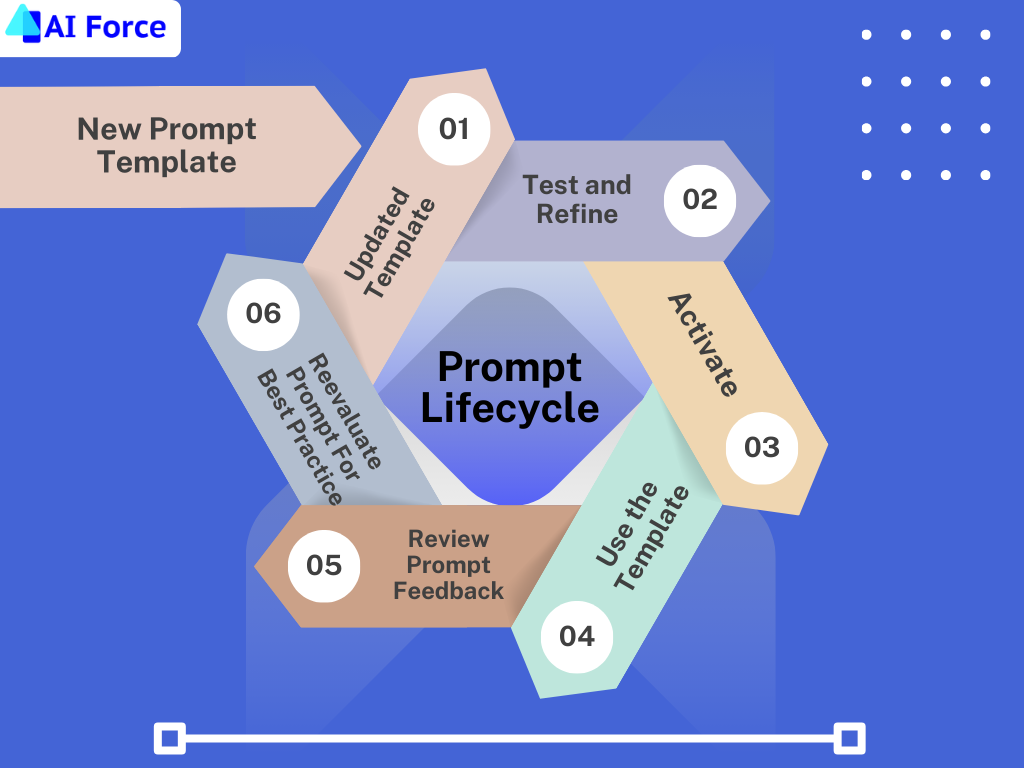Prompt Builder Intro
A Note To Start: Prompt Builder Training Content
Because of the rapid development and deployment of AI features, Prompt Builder knowledge and material from Salesforce is scattered across blogs, Trailhead, articles, Dreamforce videos, and more. Following the multiple sources of information was challenging for us, and we assume it is for you as well.
In preparing this module, we’ve pulled together as much valuable information as we could into one place to streamline your ability to learn Prompt Builder. We’ve included resources from us, Salesforce, and even best practice information identified by the AI model builders.
All 3rd party content identified below is included in good faith that you deserve the most comprehensive and expeditious training possible. I want to enable you to be the most prepared and experienced AI professional.
We believe this ideology is in line with Salesforce’s objectives as well.
Ok, let’s get started!
Source: Salesforce.com
What is Prompt Builder
Prompt Builder is a tool that allows users to create and manage AI prompts within the Salesforce platform. It’s a core component of the Einstein AI platform and simplifies the process of configuring prompts to interact with AI models for various tasks.
These tasks could be executed via:
- Flows
- Apex
- Directly by users on a record
- Agentforce agent actions
Yeah, that’s a lot! I know. That’s exactly why Prompt Builder is at the core of AI enablement for Salesforce.
Prompt Builder is your home base for generating the information that goes to LLMs to get back the results you need to automate tasks and improve workflows.
This tool is designed to be used by all types of Salesforce professionals. Without it, you cannot take full advantage of customizing AI to meet your organization’s needs.
What exactly is a prompt again?
A prompt is a structured input given to a large language model (LLM) that combines specific instructions, contextual guidance, and requirements along with relevant data.
The goal of a prompt is to direct the LLM to generate a response or perform a task based on the provided input. It can include questions, tasks, conditions, statements, instructions, and more. This defines how the model should respond. A well-designed prompt ensures that the output is both relevant and aligned with the intended purpose.
Something important to keep in mind is that the prompt includes everything added to the block or blob of text sent to the LLM.
No matter what tool you’re using or where the information comes from the text must be brought together into one big chunk that goes to the LLM. This input is what the LLM uses to determine the output.
Where does Prompt Builder Fall in the Salesforce AI Ecosystem?

Prompt Builder: A Core Component of the Einstein Platform
Prompt Builder is a part of the Einstein Platform and sits alongside the other AI Builders for Salesforce. Although it’s separated out as its own element, you must know that you can deliver AI solutions with Prompt Builder alone on the platform. However, you get the most value out of knowing how to get your prompts interacting with Agent Builder and any other builders that Salesforce deploys in the coming years.
The AI Builders like Prompt Builder sit on top of the Einstein Trust Layer, which helps ensure the generated results of the prompt have:
- The least possible bias
- The best possible grounding
- Secure data masking
- And more
You’ll soon see how the Model Agility Layer is applied to Prompt Builder, allowing you to utilize best-in-class models for whatever prompts you dream up to execute for your business requirements.
Source: Salesforce.com
Key Benefits Of Using Prompt Builder In Your Organization
Prompt Builder streamlines the integration of generative AI into your organization’s workflows. It allows you to create prompt templates that employees can use to automate and accelerate tasks, such as summarizing information or generating content, with just a few clicks.
By enriching prompts with data from your CRM, Data Cloud, and external sources, you can ensure that the AI-generated responses are more accurate and aligned with your business needs. Additionally, Prompt Builder enables you to create prompts once and reuse them across various Salesforce applications, such as Einstein Agents, Lightning pages, and flows, making it easier to augment and scale AI capabilities throughout the organization.
It’s important to keep in mind the reusability of your prompt templates across the org. When you’re building out a prompt, you’ll think through whether or not you’ll be using it in multiple places and consider your structure to make sure the same output works for the various use purposes.
Developing Prompts
Constructing a good prompt can be challenging. You have to work hard to get your prompt working just right and take into consideration all the best practice methods for generating a prompt that gives you the results you’re looking for. That’s where Prompt Engineering comes in. This is the process of determining what belongs in a prompt to get the output.
Prompt Builder helps facilitate this process by allowing you to create Prompt Templates that can be iterated on over time. You’re able to track your revisions and outputs to compare versions and sort out the best methods for achieving a specific result.
In later lessons, we’ll go deeper into the mechanics of a good prompt, how to construct one, and industry best practices. We’ll also talk about how to start with templates already available from other sources to make it easier to build out your own extensive prompts.
Source: Salesforce.com
We’re going to need a framework for understanding how to manage the process for creating and managing prompts over time. That is why we have the Prompt Development Lifecycle.

The Prompt Development Lifecycle is broken up into 6 elements. Take a look at what’s involved with each element.
Create or Update a Template
1This initial step involves creating a new prompt template from scratch or updating an existing one if the prompt has already gone through one or more lifecycle iterations. A new template should start with a clear goal and consider the intended use cases, while updates refine existing templates based on feedback or new requirements.
Test and Refine
2Once the template is created, it’s time to test it in Prompt Builder. This involves applying the prompt to various records or scenarios to see how it performs. Analyze the results for consistency, accuracy, and relevance. Iterative refinements are critical in this phase to ensure the prompt delivers optimal outputs before activation.
Activate
3After thorough testing, the prompt template is ready to be activated. This phase makes the template live and accessible for use within the organization. Activating a prompt also involves ensuring all dependencies and integrations with other systems or builders are functioning as expected.
Use the Template
4Users begin applying the prompt template in real-world scenarios. To ensure quality, it’s recommended to start with a small focus group that provides initial feedback. This phase provides valuable insights into how the prompt performs in diverse situations and helps identify potential areas for improvement.
Review Prompt Feedback
5Over time, collect feedback from users and analyze logs to evaluate the prompt’s performance. Look for patterns, such as areas where the prompt may need adjustments or where it performs exceptionally well. This feedback is crucial for maintaining and improving the prompt’s effectiveness.
Reevaluate Prompt for Best Practice
6This final stage involves revisiting the prompt after sufficient use. Use the feedback and industry best practices to refine the template further. Updates may also incorporate new findings or business requirements, ensuring the prompt remains relevant and aligned with organizational goals.
So that's how the Prompt Development Lifecycle works. It's good practice to keep this lifecycle in the back of your mind while working with prompts. Different levels of attention, effort, and skill level are required depending on where you are in the cycle.
How Is Prompt Builder Different From FlowGPT?
Some of you have been through the GPT Specialist Training module on FlowGPT, and it’s important to understand the differences between FlowGPT and Prompt Builder. If you haven't been through that training, then simply skip this section.
The upside to using FlowGPT is that you can quickly add AI to a flow for a specific purpose. You get to stay inside the flow when you build out the AI interaction. This helps you better understand exactly what’s needed for the prompt while building your AI solution directly where it will be used.
- You can turn on your flow, test, diagnose, and update your prompt all in one place to achieve the best results.
- It leverages the Prompt Engineering Framework to build specific AI solutions following best practices.
On the other hand, Prompt Builder offers a more intuitive user experience for creating prompts. It allows you to:
- Test a prompt and see its results independently of where it’s used.
- Use the same prompt across the platform, not just within a flow.
- Easily view all your prompts in one place without needing to access a specific flow.
- Track revisions and perform additional actions with your prompts.
Drop Into Focus
Quiz Time!
Now that you have a better understanding of Prompt Builder overall, let's talk next about the different types of templates available to you in Salesforce!

